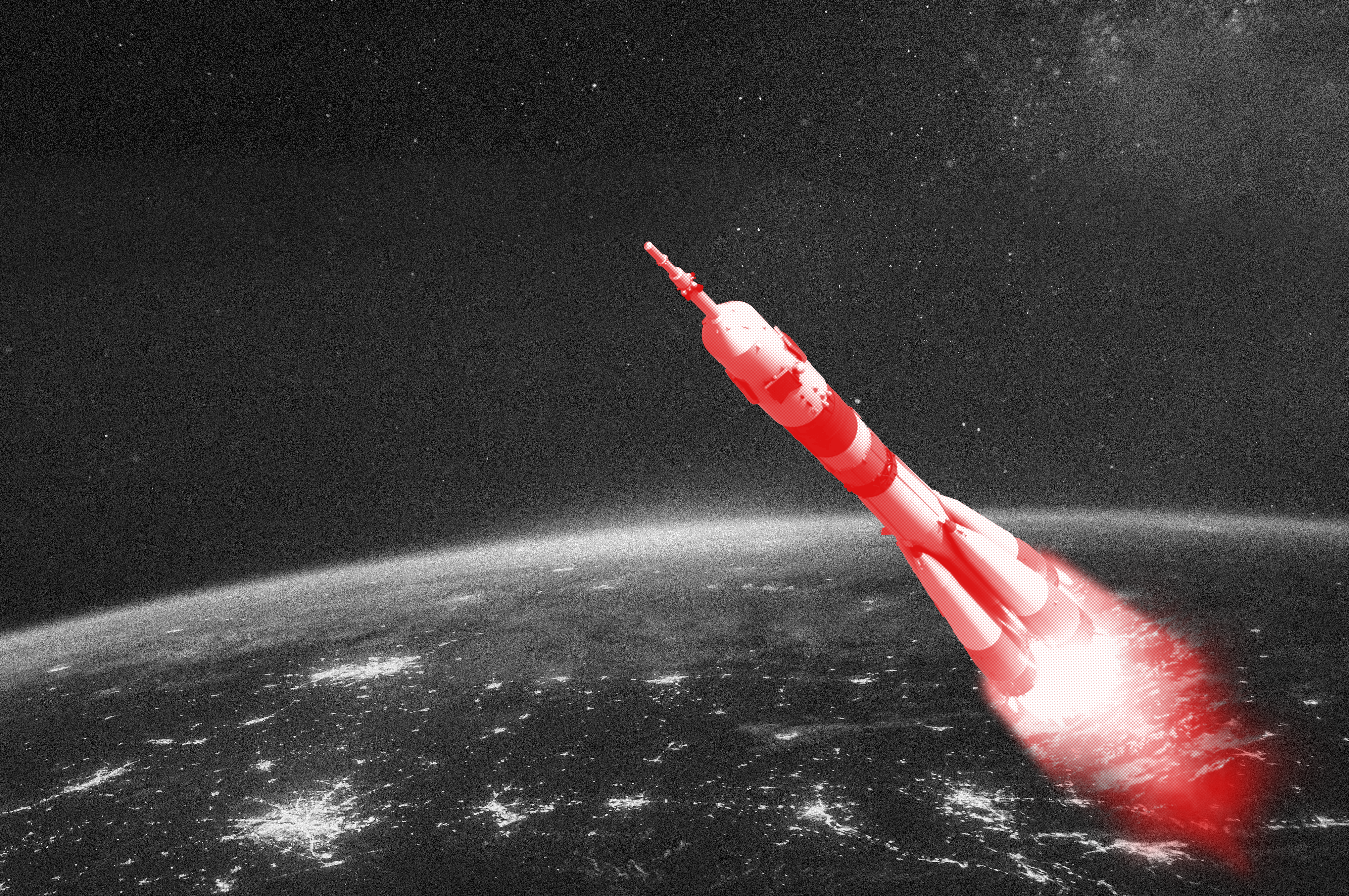The New Space Race
As billionaires pursue other-worldly experiences, UH’s space experts dive into how we are navigating a new kind of interstellar chase.
By Shawn Shinneman

UH Space Expert Olga Bannova
UH Space Expert Olga Bannova
In the 1960's, Barron Hilton was so sure we would eventually have human beings living beyond Earth that he endorsed a plan for the Lunar Hilton, an underground hotel on the moon, complete with a space station and sleek room keys. In perhaps a nod to the timeline Hilton was considering, a mock-up reservation card advertised by the company included the “date of travel” to occur in the 1980s.
“He presented a talk on the future of space tourism and basically said Hilton [Hotel] wants to be there,” says Mark Young, a University of Houston archivist and historian who focuses on hospitality. “And it caught wind. The media picked up on it. And we’ve got, in the archives, files of letters people wrote wanting reservations. They came in from around the world.”
"The inclusion of private industry distinguishes the new space race."
Hilton did not get to see his idea come to fruition. But lately, something interesting is happening in the world of space travel. People are once again invigorated by the idea of exploring, if not living, outside the confines of the Earth’s atmosphere. Billionaires have thrown their fortunes behind the cause.
As Hilton’s intentions show, commercial interests were also looking to get a slice of the pie, even back then. But that’s where comparisons end between the original space race and the one taking root today. Hilton was relying on government-funded space exploration to do the legwork. These days, the billionaires in the mix are a guiding hand in shaping the future of cosmic expeditions.
A Brand New Space Race
The space race of the ’60s was a time of intense competition. Developments were fueled by patriotism and rivalry, with the U.S. and the Soviet Union trading barbs as they pushed technological limits.
“The Soviets were the first to send up a satellite—and from my understanding, it wasn’t very significant that they sent one up in ’57, and we sent ours up in ’58,” Young says. “But to the American public, it was just, you know, oh my God. It scared a lot of people.”
As a percentage of total federal spending, NASA’s funding peaked in 1965 and 1966, when it represented more than 4% of the U.S. budget. Today, that figure hovers around half of a percent.
Yet, nearly six decades later, we’re entering a new era of exploration. This new space race features many more players—not only the U.S. Involvement from countries like China, Japan and India has led to a steady drumbeat of advancement. In August, when its Chandrayaan-3 touched down, India became the fourth nation to land a spacecraft on the moon—and the first to plant it on the rugged terrain of its south pole.
But the entrance of these nations is just part of the story. The inclusion of private industry distinguishes the new space race. Some of the wealthiest people in the world have thrown their weight behind research and development. Elon Musk’s SpaceX has even found a way to turn a small profit, returning $55 million in income from $1.5 billion in expenses during the first quarter of 2023, ac- cording to the Wall Street Journal. It makes money selling rocket launches to NASA, helping governments or other companies deploy satellites and offering space tourism experiences for as much as $1 million per voyage.
Billionaires Jeff Bezos, Richard Branson and Mark Zuckerberg are also in the mix. The first two have been to space themselves on crafts built by their own companies. The latter wants to plant a camera and a computer chip on a postage stamp-sized, robotic “ship” and transport it by laser up to 100 million miles per hour to the star system Alpha Centauri. It’s a trip that would typically take 30,000 light years but, at a quarter of the speed of light, would take the Zuckerberg-backed Starshot Project just 20.
And it’s not just the big names getting in on the fun. Led by Houston-based Axiom Space, several companies have been exploring commercial activities in low earth orbit.
“There are several goals right now that agencies and companies are pursuing, and it’s all very exciting,” says Olga Bannova, who serves as director of UH’s space architecture graduate program. “That’s what makes it different. There are several options to explore right now, and more and more startups are finding success.”
Bannova hopes the myriad players will come together in conversation and share what works and what doesn’t. When she takes students through the first space race's ups and downs, they all conclude: We would’ve gotten a lot further if it was a collaboration, not a race. Competition might’ve driven investment, but it also caused redundancy.
"When it comes to space, the more we know, the less we understand."
She’s optimistic it will be different this time around. The commercial interests in the mix may compete with each other, but there’s much to be gained from collaborating and sharing successes and failures. “It’s about testing and speeding up the process,” Bannova says. “And getting a return on your investment faster.”
Yet, despite some lofty goals, colonization remains a pipe dream—for now. Decades later, whether or not it will actually happen is still very much up in the air. When it comes to space, the more we know, the less we understand. To have people not only living on the moon or Mars but remaining there, birthing new generations and accessing all the things human beings need to survive would require connecting a lot of dots.
“There are so many things that need to be solved,” says Bannova, “before we can say, ‘Yeah, we can colonize.’”

Building the Backbone of Space Travel
As the only one of its kind in existence, it’s no wonder Cullen College’s space architecture program pulls in students from around the world—and, upon graduation, places them with some of the largest companies exploring space today. UH initially created the program because of a demand from the industry—specifically, from NASA, which needed somewhere their engineers could study and earn a degree.
Since its founding 36 years ago, the program has been developing new ways to prepare students for a career in the industry.
Since its founding 36 years ago, the program has been developing new ways to prepare students for careers in the industry. Directors & professors are currently working on perfecting an augmented reality training room that provides students—through the power of green screens, props, harnesses and mixed reality goggles—an immersive and realistic training experience, complete with an upper-body suit that restricts movement similar to a spacesuit.
“Our main focus is problem-solving based on a multidisciplinary approach,” Bannova says. “Learning from each other.”
She says the program has been flooded with applications. Amid this renewed energy, she’s hearing more and more of her students voice their aspirations for a career path they would’ve rarely considered before. They’ve been telling her they want to start their own companies.

Students Paolo Mangili and Vittorio Netti preparing for a mixed reality space walk.
Students Paolo Mangili and Vittorio Netti preparing for a mixed reality space walk.
Cosmic Problems With Nebulous Solutions
Bannova is at no risk of running out study topics. The “research interests” section of her bio reads like a Star Trek script, calling out topics like “inflatable hydroponics laboratory and logistics modules” and “special design influences and requirements for different gravity conditions in space.”
Lately, her mind has been occupied with how we may protect human beings from space radiation.
Whereas Earth’s atmosphere protects us from radiation produced by the sun and exploding stars thousands of light years away, the moon does not enjoy the same defense. NASA is planning new trips to the moon with ambitious plans to have astronauts live on the lunar surface for months. But so far, little is known about the effect of prolonged exposure to space radiation.
Bannova plans to present a paper on the topic soon. “It explores different methods of how radiation protection could be integrated with the structures and architectures on the moon and Mars,” she says. Radiation protection, Bannova explains, would be a major development.
So would, for that matter, significant improvements to propulsion systems that reduce the travel time between Earth and the moon or Mars. “Faster is better,” she says.
And then there’s sustainability. Bannova is mindful of how any structures human beings may put on planets will interact with their environment long after they have served their purpose and become obsolete.
“Stuff starts growing, and there are materials in the walls that will seep into the atmosphere,” she says. She wants the key players to think about the lifecycle of new structures as a closed loop, eliminating waste. “Thinking about, start to end, how they can be utilized for a variety of different purposes in the future.”
Just what those purposes are will depend on how technology advances. Barron Hilton may have been sure that life on the moon was inevitable. But Bannova is taking it day by day.
“It’s heavily dependent on the technology,” she says, “and on the next big discoveries.”





